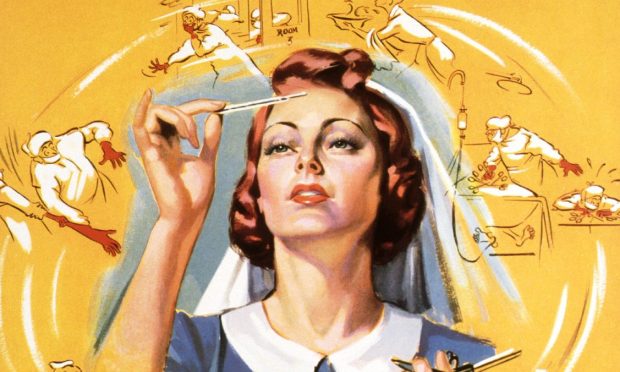
Smearing egg whites on pressure sores, serving Guinness to new mums and rolling cigarettes for patients: traditional nursing practice from yesteryear may raise modern eyebrows.
Yet these were integral to life on wards for decades, and many of these seemingly outdated treatments still endure.
The history of Britain’s wards is explored in Rituals & Myths In Nursing, a new book which charts the origins of the profession from Florence Nightingale to its more evidence-based approach today.
“Smearing egg whites onto pressure sores and then leaving the exposed skin to dry, encouraging the process by firing oxygen at it, is something that mid-20th Century nurses the world over will have come across,” said author Claire Laurent, who is a former nurse.
“In fact, I was going to call the book Egg White And Oxygen because every former nurse would immediately connect with the title.”
On certain wards, the sight of nurses serving alcohol was a common one.
“For some nurses working on mid-20th Century wards, especially male surgical, there was a drinks trolley round at 11.30am,” added Claire.
“That included sherry to encourage appetite, Guinness for women on the postnatal wards to boost iron levels and, on the vascular wards, brandy and whisky were given to encourage dilation of blood vessels. And in fact it is still sometimes prescribed today – sherry is good for encouraging appetite in older people, for instance.”
Early beginnings
Nursing, Claire explained, began before even Florence Nightingale’s famous exploits in the Crimean War. Although she did much to professionalise nursing, much of the early practice on wards was, like a lot of medicine of the period, based on traditions rather than evidence.
Poultices and ensuring patients had enough cigarettes were part of a nurse’s duties. Applying leeches or honey was common, which may feel like a form of folk medicine to modern sensibilities.
“Leeches have long been used in the care and treatment of patients – coming in and out of fashion over the years,” explained Claire. “Leeches are used to relieve an area congested with blood by sucking it up, they can be applied to those undergoing plastic surgery.
“Meanwhile, maggots are still sometimes used for wounds that won’t heal. Research has shown that their secretions contain an enzyme which can kill bacteria because they disinfect as they work and they also stimulate the growth of healthy tissue.”
Honey, which was applied to wounds to encourage healing, is still in use today after it was shown to have antibacterial and anti-inflammatory properties.
Claire points to the treatments which not only didn’t work but were harmful – such as the use of Edinburgh University Solution of Lime, an antiseptic solution used to clean wounds, prepared from chlorinated lime and boric acid, which was found to be harmful.
Calls for a return to classic matron-run wards, where qualifications were more likely to be based on a trainee’s quality of needlework, rather than exam results, aren’t welcome in the beleaguered modern nursing profession, either.
“I and many others are very tired of people wishing nurses were less well educated,” said Claire. “The better educated your nurse, the more likely you are to survive, get well and go home.
“And if nurses are caring for you in your own home, then you are really fortunate, because the community nursing profession has been devastated by cuts in numbers over recent years, yet they provide a vital service, enabling older people to stay at home for longer, for instance.”
The nursing profession
Early nursing in the 20th Century had similarities with military culture, with strict uniform code and matrons wielding set squares to measure how neatly beds were made.
Sadly, it was also common for male doctors to bully nurses, and sexual harassment was commonplace.
“It’s tiresome but sexism and harassment is everywhere for women and always has been,” said Claire. “I think the way nurses are portrayed in the media and the way women are treated as lesser makes itself felt among nurses.
“Female nurses are not angels, or there to feed men’s sexual fantasies. They are educated people who work in a safety critical profession.”
Whether it’s similarities or differences in the way medicine is practised, certain aspects of nursing have remained constant, according to Claire.
“Nurses should be applauded for our ability to adapt to meet the demands of a really complex job,” she added. “New rituals develop all the time.
“But, I would say the nature of being ill and needing care and kindness is the same. Nurses today are far more stretched and short-staffed than they were when students trained on the wards as an extra pair of hands, so there are fewer people to do the caring. It’s a complex profession, but our shared experiences are part of what makes it fun. You are part of a team, a tribe, a profession that has its own shorthand communication.”
Rituals & Myths In Nursing: A Social History by Claire Laurent, available on Amazon or clairelaurent.co.uk

Enjoy the convenience of having The Sunday Post delivered as a digital ePaper straight to your smartphone, tablet or computer.
Subscribe for only £5.49 a month and enjoy all the benefits of the printed paper as a digital replica.
Subscribe